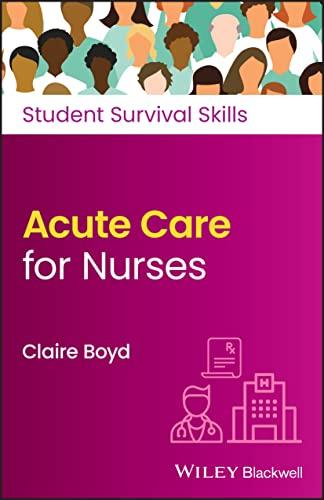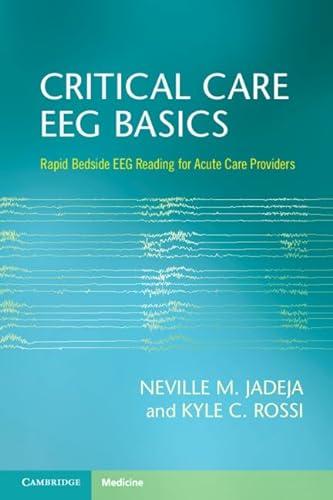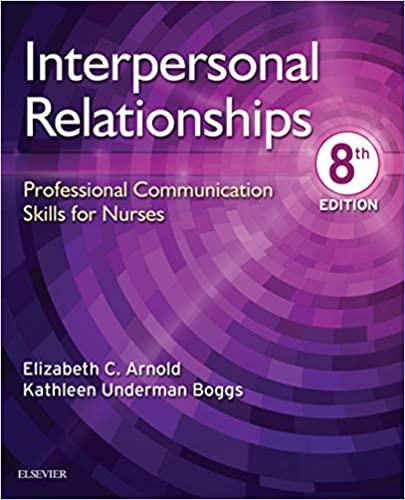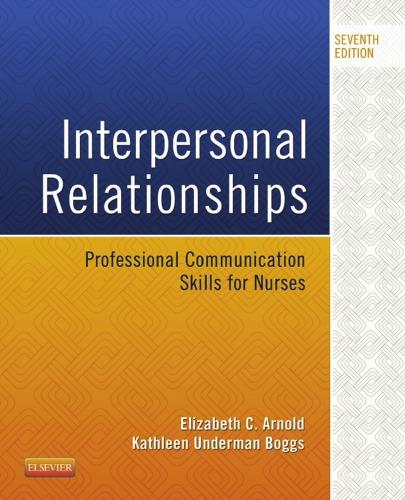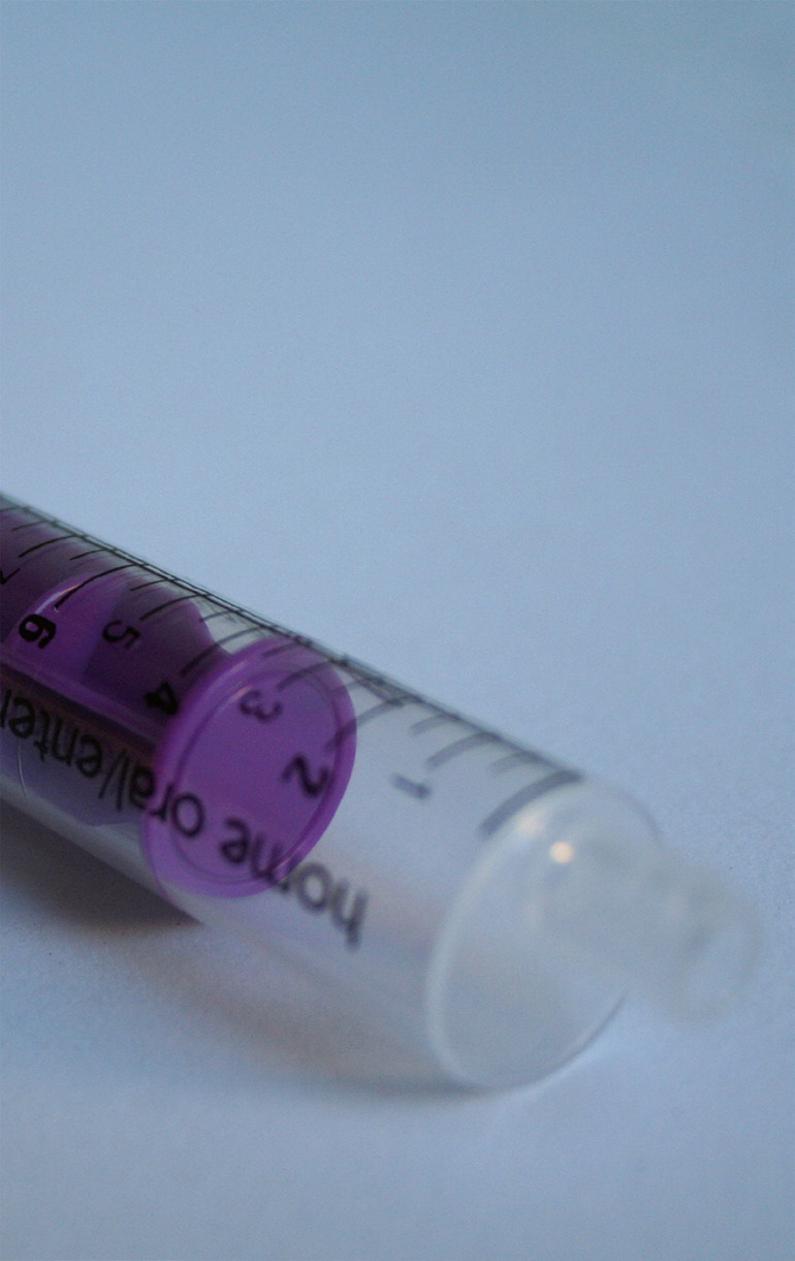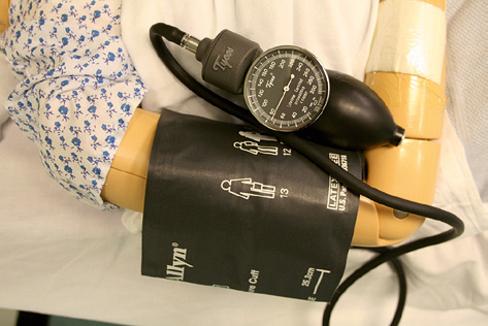ACUTE CARE FOR NURSES
Claire Boyd RGN, Cert Ed
Practice Development Trainer
Bristol, UK
This edition first published 2023 © 2023 John Wiley & Sons Ltd
All rights reserved. No part of this publication may be reproduced, stored in a retrieval system, or transmitted, in any form or by any means, electronic, mechanical, photocopying, recording or otherwise, except as permitted by law. Advice on how to obtain permission to reuse material from this title is available at http://www.wiley.com/go/permissions.
The right of Claire Boyd to be identified as the author of this work has been asserted in accordance with law.
Registered Offices
John Wiley & Sons, Inc., 111 River Street, Hoboken, NJ 07030, USA
John Wiley & Sons Ltd, The Atrium, Southern Gate, Chichester, West Sussex, PO19 8SQ, UK
For details of our global editorial offices, customer services, and more information about Wiley products visit us at www.wiley.com.
Wiley also publishes its books in a variety of electronic formats and by print-on-demand. Some content that appears in standard print versions of this book may not be available in other formats.
Trademarks: Wiley and the Wiley logo are trademarks or registered trademarks of John Wiley & Sons, Inc. and/or its affiliates in the United States and other countries and may not be used without written permission. All other trademarks are the property of their respective owners. John Wiley & Sons, Inc. is not associated with any product or vendor mentioned in this book.
Limit of Liability/Disclaimer of Warranty
The contents of this work are intended to further general scientific research, understanding, and discussion only and are not intended and should not be relied upon as recommending or promoting scientific method, diagnosis, or treatment by physicians for any particular patient. In view of ongoing research, equipment modifications, changes in governmental regulations, and the constant flow of information relating to the use of medicines, equipment, and devices, the reader is urged to review and evaluate the information provided in the package insert or instructions for each medicine, equipment, or device for, among other things, any changes in the instructions or indication of usage and for added warnings and precautions. While the publisher and authors have used their best efforts in preparing this work, they make no representations or warranties with respect to the accuracy or completeness of the contents of this work and specifically disclaim all warranties, including without limitation any implied warranties of merchantability or fitness for a particular purpose. No warranty may be created or extended by sales representatives, written sales materials or promotional statements for this work. The fact that an organization, website, or product is referred to in this work as a citation and/or potential source of further information does not mean that the publisher and authors endorse the information or services the organization, website, or product may provide or recommendations it may make. This work is sold with the understanding that the publisher is not engaged in rendering professional services. The advice and strategies contained herein may not be suitable for your situation. You should consult with a specialist where appropriate. Further, readers should be aware that websites listed in this work may have changed or disappeared between when this work was written and when it is read. Neither the publisher nor authors shall be liable for any loss of profit or any other commercial damages, including but not limited to special, incidental, consequential, or other damages.
Library of Congress Cataloging-in-Publication Data applied for ISBN: 9781119882459 (paperback)
Cover Design: Wiley
Cover Images: © chuwy/Getty Images; © rambo182/Getty Images
Set in 9/12pt Trade Gothic Light by Straive, Pondicherry, India
Introduction
Hello, my name is Claire, and those of you who have read the other books in this series will know that I have been in health care for more than 40 years, beginning my nursing career as a Nursing Auxiliary (Healthcare Assistant). After completing my training to become a Registered General Nurse and later obtaining a Certificate in Education to become a Teacher/Lecturer in health care, I began teaching medics, nurses, students, among others, in clinical skills.
As with other books in the series, this book has been divided into four sections. Part 1 begins by looking at some medication management formulas as revision before going on to look at some more advanced formulas you may see in the clinical setting. As these books are what you want, it was requested, by readers just like you, that sepsis and conflict resolution chapters were added.
• Sepsis was included because of the fact that healthcare systems worldwide, including our beloved NHS (National Health System), have pledged to reduce the number of infections and deaths by early recognition and treatment.
• Conflict resolution was added because of the assaults on healthcare staff. We’ve all seen angry patients and their families upset that visitors have been banned because of the coronavirus disease 2019 pandemic; others were furious that they were asked to wear masks in the hospital setting or because of cancelled clinics as a result of staff needed to cover for their sick colleagues in the ward areas. In truth, assaults by those we are trying to care for is nothing new.
Part 2 looks at assessment techniques and the individual components of the ABCDE assessment, moving on from the vital signs clinical observation at a superficial level and looking at the individual components more in depth, as well as the clinical actions performed by the more experienced nurse.
Part 3 focuses on some of the higher skills, such as caring for the ventilated patient, fluid resuscitation in adults and children, and subcutaneous fluid hydration in those unable to tolerate the intravenous route. Without adequate hydration, patients will die very quickly.
Throughout the book we will look at real-life scenarios, with questions at the end of chapters to consolidate our understanding.
You will find a soupçon (that’s a posh word for ‘sprinkling’) of humour, as goodness knows nursing is a stressful profession at the best of times, never mind adding pandemics and winter pressures to the mix!
A man speaks frantically on the phone: ‘My wife is pregnant and her contractions are only two minutes apart’!!
Midwife: ‘Is this her first child’?
Father: ‘No, you fool’, he shouts. ‘This is her husband’!!
Everything has been designed as a quick overview read, cutting out the waffle (and perhaps ‘the nice to know’) and relaying only the important, vital information. See the information box below as an example as to what I mean:
HOW TO SWITCH ON A LIGHT SWITCH
VITAL:
1 Go to light switch.
2 Using index finger of dominant hand, press down switch to turn on.
NICE TO KNOW:
You did not need to know how electricity is generated, how it is supplied to dwelling, how the fuse box is wired, how the light switch is wired, etc., as asked only to switch on the light switch!
Thank you to the students, and others, for writing and verbalising what you wanted covered in this book, thereby getting it right for you, the healthcare professional.
Source: tommoh29 / Adobe Stock.
DIAGNOSTIC TESTS AND ADVANCED FORMULAE
LEARNING OUTCOMES
By the end of this chapter you will have an understanding of how to calculate mean arterial pressure (MAP), drug administration calculations, percentage strength of drugs, solution strength of drugs (e.g., mg/ml), infant feeding regimens, infant growth expectations, body surface area (BSA), and body mass index (BMI); how to measure cardiac output (CO); how to assess lung function and renal clearance; and how to determine energy requirements of the body.
Working in health care, we all need to have a good grasp of mathematics to perform our professional duties, such as keeping accurate fluid balance records (see Appendix 3), totting up the vital signs on the National Early Warning Score 2 observation chart (see Appendix 1), and administering medications, to name just three. As our careers progress, we may be involved in more complex mathematics. This may involve having an understanding of body organ and systems calculations. Even if you are not expected to undertake these calculations, it is still good to have the knowledge of how these readings are obtained and what they mean to the patient’s health.
MEAN ARTERIAL PRESSURE
For instance, in Chapter 2 we will look at mean arterial pressure (MAP) of blood pressures (BPs) in relation to sepsis. This reading often pops up on automatic BP machines (electronic sphygmomanometers), but what exactly is it and how do we obtain this reading if using a manual sphygmomanometer (aneroid), as shown in Figure 1.1, with a stethoscope?
Mean arterial pressure (MAP)
MAP is the average blood pressure of an individual during a single cardiac cycle and informs us whether the blood flow is adequately perfusing the tissues/organs. This is a vital calculation for patients in critical care and in cases of septic shock.
Working out the MAP from a BP recording is actually very simple:
Step 1: Take BP recording.
Step 2: Multiply the diastolic BP (DBP) by 2.
Step 3: Add this value to the systolic BP (SBP) and divide by 3.
Example: BP: 120/80 mmHg
DBP: 80 × 2 = 160
160 + 120 (SBP) = 280
Divide by 3 = 93.3
Figure 1.1 Aneroid sphygmomanometer.
Activity 1.1
1 Work out the MAP of BP 135/85 mmHg.
2 Work out the MAP of BP 120/70 mmHg.
DID YOU KNOW?
The normal MAP range is between 70 and 100 mmHg. The body needs at least 60 mmHg to provide enough blood to the coronary arteries, kidneys, and brain.
HEALTHCARE CALCULATIONS
Before we look at some more advanced body organ and systems calculations, we will first revise our more everyday or ‘bread and butter’ drug administration calculations.
Drug Dosages for Tablets/Capsules
A patient has been administered 0.25 mg of digoxin orally. Stock: 250-microgram (μg) tablets. How many tablets do you administer?
First, change 250 μg to milligrams (mg): 250 μg/1000 = 0.25 mg.
WYW: 0.25 mg
WYG: 0.25 mg = 1 tablet
Question 1.1
Prescription: 8 mg morphine
Stock: 10 mg/2 ml
How much do you administer?
Drug Dosages for Injections, Syrups, Elixirs, Among Others
A patient requires a subcutaneous injection of 22 units. 10 ml stock ampoules contain 100 units to every 1 ml. What volume do you draw up?
Question 1.2 A patient is prescribed 400 μg of Granisetron syrup orally. Stock solution = 1 mg/5 ml. How much do you draw up?
Infusion Pump Rates (in millilitres per hour)
A patient is to receive 4 l of 0.9% sodium chloride over eight hours. What is the infusion rate in millilitres per hour?
Question 1.3 350 ml of blood is to given to a patient over four hours. What is the infusion rate in millilitres per hour?
Drip Rates (in Drops per Minute)
Formula Volumeml
:
The patient has been prescribed 1 l of 5% glucose to run over eight hours. What is the infusion rate in drops per minute, using a standard administration set delivering 20 drops/ml?
Changelitreintomlml11000
Question 1.4 Patient has been prescribed 0.5 l of fluid to run over five hours. What is the infusion rate in drops per minute, using a blood administration set delivering 15 drops/ml?
Duration of Infusions
Formula
Volume Rate Dropsperml 60minutesperhour :
600 ml of fluid is dripping at 20 drops/min. The intravenous (IV) set delivers 15 drops/ml. How long will the infusion take?
TO p TI p
Question 1.5 An IV set delivers 15 drops/ml. A patient is to receive 1 l of Intralipid at 30 drops/min. How long will the infusion take?
0.33 does not mean 0.33 minute. This is a decimal value and needs to be changed to minutes by doing the following conversion:
Drugs According to Body Weight
FormulaTotaldoseperdayWeightkgDose:
A patient with diabetic ketoacidosis needs to commence a fixed rate insulin infusion at 0.1 unit/kg/h as per trust policy. How much insulin should be prescribed to an 85 kg patient?
WeightDoseunitsh 850185../
Question 1.6 A patient has a deep vein thrombosis and has been prescribed enoxaparin (low-molecular-weight heparin). The patient weighs 74 kg. The dose of enoxaparin is 1.5 mg/kg. How much do you administer?
DID YOU KNOW?
I think my calculator is broken. The only numbers that seem to work are 1, 3, 5, 7, and 9. It’s very odd.
Calculating How Many Minutes Drug to Run Over
Formula Doseprescribed Rate :
Furosemide should not exceed 4 mg of the run over one minute because of speed shock. A patient has been prescribed 20 mg. Over what time should this be administered?
Doseprescribed Rate minutes 20 4 5
Speed shock
A systemic reaction caused by the rapid injection of a medication into the circulation, resulting in toxic levels of medication in the plasma. Symptoms can include cardiac arrest, flushed face, headache, irregular pulse, shock fainting, and tightness in the chest.
Question 1.7 A patient has been prescribed 15 mg. Over what time should this be administered?
Percentage Strength of Drug
A patient is given 2 l of 0.45% sodium chloride. How many grams of sodium will the patient receive?
Changelintomillilitresml22000.
Question 1.8 How many grams of medication do you have in 20 g of 12% w/w ointment?
Solution Strength of Drug (mg/ml)
500 mg of amoxicillin powder has been reconstituted in 25 ml of water for injection. What is the concentration in milligrams per millilitre (mg/ml)?
500 25 20mgml /
Question 1.9 1 g of a drug has been reconstituted in 20 ml of water for injection. What is the strength in mg/ml.
Extra Questions
And now a couple of questions for you to do on your own – just for your own enjoyment!
Question 1.10 A patient is given 0.9% sodium chloride at a rate of 400 ml/h for five hours. How many litres will the patient receive?
Question 1.11 An infusion of dextrose 5% started at 10:00 and finished at 22:00. How many litres will the patient have received if the infusion is running at a rate of 100 ml/h?
Question 1.12 A patient has been prescribed ibuprofen 5 mg/kg/d in three divided doses. The patient weighs 60 kg. Calculate the daily dose and single dose.
DID YOU KNOW?
OD = Once daily
BD = Twice daily, or 12 hourly
TDS = Three times daily, or 8 hourly
QDS = Four times daily, or 6 hourly
Question 1.13 Stock ampoules of IV hydrocortisone = 100 mg in 2 ml. Patient requires 135 mg IV. How much would you administer?
Question 1.14
A patient is to have 2 l of clear fluid in 24 hours. He has received 1500 ml in 6 hours. How many drops per minute are required to correct the infusion?
TO
p TI p
If you struggled with any of these calculations, perhaps you may wish to read the calculations book in this student survival series set of books.
Now let’s look at some advanced body, organ, and systems calculations starting with infant feeding regimens.
CALCULATING INFANT FEEDING REGIMENS
Obviously, correctly preparing feeds for bottle-fed babies is important. A hungry baby usually cries between feeds, and an overfed baby can experience diarrhoea and vomiting.
Infants need to receive 150–200 ml per kilogram body weight per 24 hours. Here is the formula for calculating feed:
VolumeoffeedAmountofmilkml Numberoffeedsin24hours Weigh / ttofbabykg
Activity 1.2
Calculate the volume of feed for a baby weighing 4.9 kg. He is fed six times every 24 hours. Remember that you need to calculate for the least (150 ml) and the most (200 ml) amounts.
WORKING OUT INFANT GROWTH EXPECTATIONS
A newborn baby is expected to regain birth weight after two weeks and then gain the following:
200 g per week until three months of age
150 g per week for a further three months
100 g per week until nine months of age
Three months is assumed to equal 13 weeks.
Imagine that you are required to calculate the expected weight of an infant aged 12 weeks whose birth weight was 3.2 kg. After two weeks, this infant weighs 3.2 kg again. The answer is:
12 2 = 10 weeks
At 200 g/week = 10 × 200 g = 2000 g = 2 kg
Therefore, the expected weight = 3.2 kg + 2 kg = 5.2 kg at 12 weeks old.
Activity 1.3
You are required to calculate the expected weight of an infant aged 12 weeks whose birth weight was 2.2 kg. After two weeks, this infant weighs 2.2 kg again.
BODY SURFACE AREA
ESTIMATIONS
For neonates and children, body surface area (BSA) estimates are more accurate than body weight when calculating drug dosages.
As people grow in height and weight, their skin surface area increases – this BSA is measured in square metres (m2).
The most commonly used simplified formula to determine BSA is the Mosteller formula, which is expressed as:
Body surface area: the square root of product of the weight in kilograms multiplied by the height in centimetres divided by 3600. The result is in square metres.
Or how I express this:
BSAmheightcmweightkg 2 3600
Then, to calculate BSA using this formula, I get my calculator: I put in the height (or length) of the child in centimetres and multiply it by the weight of the child in kilograms. I then divide the result by 3600 (do not worry about where the 3600 comes from, just go with it). When I have an answer, I press the square root button on my calculator to get the BSA in square metres (m2).
Here is an example that walks you through the steps.
Your first patient of the day is a woman 1.70 m tall and weighing 65 kg – you need to calculate her BSA:
1 Convert metres into centimetres. 1100 170100170 metrecentimetresandso centimetres ,
2 Multiple height by weight. 1706511050 ,
3 Divide the result in step 2 (11 050) by 3600. 30694.
4 Find the square root using a calculator. 1752 .m
Activity 1.4
You need to find the BSA of a small child weighing 16.4 kg whose height is 100 cm.
However, many people use a scale called a nomogram to estimate BSA, although it is considered to be much less accurate that the Mosteller formula. There are separate nomograms for infants, children, and adults. Figure 1.2 shows the nomogram for infants for working out the BSA.
Let me show you how to use the nomogram. First, get a ruler or something with a straight edge. If you want to find the BSA of an infant with a length of 70 cm and a weight of 32 kg, place the straight edge on the height scale at 70 cm and across to the weight scale at 32 kg. The straight edge crosses the surface area scale at approximately 0.78. This means that the BSA is 0.78 m2. Try this out for yourself on the nomogram.
Now, put the same details into the Mosteller formula:
Heightweightcmkg 3600 7032 3600
Nomogram for infants.
Figure 1.2
Using your calculator, input: 703222403600062 /.
Then find the square root, or press the square root button on your calculator, and you get 0.79 m2
The formula method and the nomogram method often give variable answers!
Table 1.1 shows some useful parameters of average values when administering medications to children, which should be used only if you are unable to find specific doses. NOTE: You will always need to check this first with the prescriber. Table 1.1 Useful approximate values.
BODY MASS INDEX
The body mass index (BMI) is the most commonly used measurement of obesity, but it is also used to check that individuals are within a healthy range. A high BMI is associated with an increased risk for ill health, such as cardiovascular disease.
The following is the formula for working out someone’s BMI:
The World Health Organisation classifies weight into BMI ranges (see Table 1.2).
Table 1.2 World Health Organisation weight classifications.
Activity 1.5
Robert Simons is a student nurse. His height is 1.72 m and he weighs 66 kg. Work out his BMI using the formula and his weight classification according to the World Health Organisation.
MAKING ORGAN AND SYSTEMS
CALCULATIONS
Some of the calculations you need to perform in the healthcare setting are in relation to the bodily organs and systems, such as cardiac output (CO) measurements, lung function, and renal clearance measurements, to establish how healthy, or poorly, your patients are. This section looks at the calculations and formulae used to gather this information.
MEASURING CARDIAC OUTPUT
CO is the amount of blood pumped by the heart’s left ventricle (in millilitres) in one minute (expressed as ml/min). It is dependent on the amount of blood pumped out with each ventricle contraction – known as the stroke volume (SV) – and the heart rate (also known as the pulse rate [P]). The SV at rest in the standing position averages between 60 and 80 ml of blood in most adults.
Here are some of the factors that increase CO:
• Anaemia
• Cirrhosis of the liver
• Pregnancy
• Severe infection
• Thiamine deficiency (beriberi)
To work out the CO, you can use the following formula: COSVbeatsperminutesP
This formula is often expressed as CO = SV × P = ml/min.
Given the SV and Ps shown in the following list, the resulting COs are as follows:
SV = 70 ml, P = 70 beats/min: CO = 70 × 70 = 4900 ml/min
SV = 69 ml, P = 65 beats/min: CO = 69 × 65 = 4485 ml/min
SV = 70 ml, P = 60 beats/min: CO = 70 × 60 = 4200 ml/min
SV = 65 ml, P = 62 beats/min: CO = 65 × 62 = 4030 ml/min
